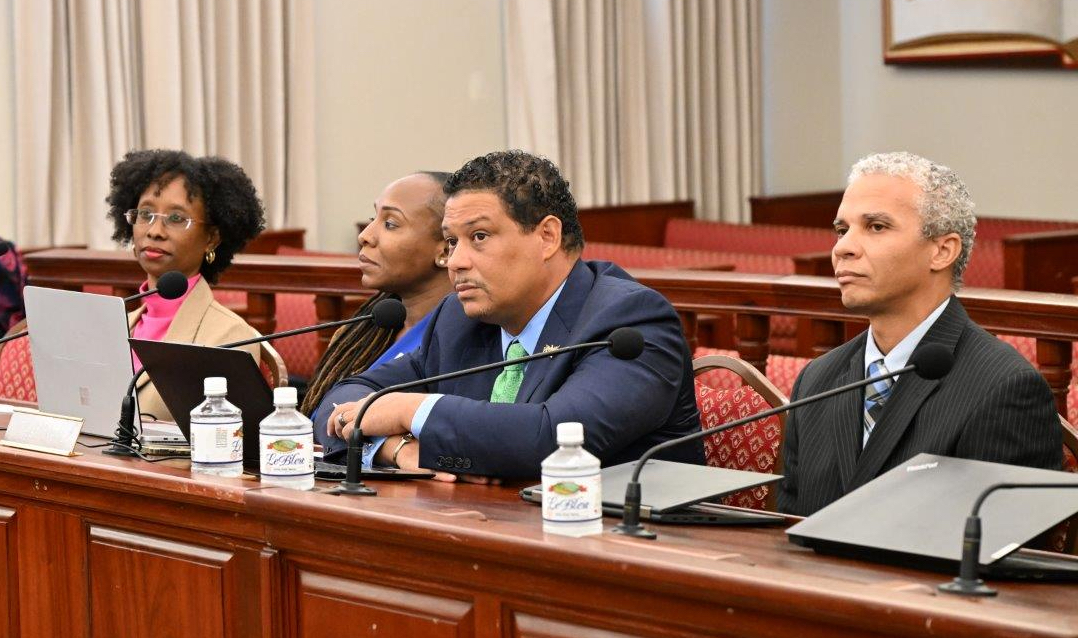
A long-awaited roadmap for development and preservation of the territory’s land and water could be a reality before the end of the calendar year, officials told the Senate’s Committee on Disaster Recovery, Infrastructure and Planning Monday.
Jean-Pierre Oriol, commissioner of the Department of Planning and Natural Resources, said the Comprehensive Land and Water Use Plan would address sustainability, economic development, protection of natural resources, and building a livable community.
Calls for the plan date back decades. In a March 2000 Source article, then-Sen. Gregory Bennerson bemoaned the comprehensive strategy had been stalled since 1992. The lack of a plan weakened the territory in the eyes of potential investors, Bennerson said.
Oriol said the forthcoming plan would allow more flexibility in development by clearly outlining expectations. Zoning changes would be reduced because industrial, residential, and commercial zones would be obvious and individually broad in scope. There would also be an emphasis on maximizing green space.
“The Comprehensive Plan is not — I repeat, is not — a regulatory tool, but rather, a framework for how we make decisions,” Oriol said. “At the end of the day, we all want similar things.”
A series of public information-gathering sessions was invaluable in shaping the plan, he said.
“Some of the more common things we heard were: no more spot zoning, eliminate the two-tier permitting system, more local control over land use decisions, protect beaches, guts, access to the shoreline, groundwater and drinking water, and make it easier for people to walk, and enforcement must be a priority,” Oriol said. “If the departments do not have the enforcement tools that they need, then all this is for naught.”
Committee Chair Sen. Milton Potter agreed, saying it’s certainty of being caught, not the severity of punishment, that changes bad behavior.
Fines for violations could be based on the level of infraction and the overall cost of the overall development, Oriol suggested.
The meetings, held on all three major islands, yielded different results each time, with the common theme being a need for enforcement, Oriol said.
“St. John just wants to ensure they are not forgotten,” he said of the island, where many expected amenities and services are not available due to its lack of land. “You’re dealing with less land, less water area, but you are still trying to ensure there are services for people.”
People wondered why there was no police station in Coral Bay, for example.
“When we met with St. Croix, there was a push that agriculture was not only protected but enhanced,” Oriol said. “It was not necessarily for export but to take care of ourself as well.”
In densely populated St. Thomas, people yearned for flexibility in zoning that would allow for a blend of commercial and residential spaces.
“We’re trying to get to a place where we’re allowing more mixed uses just because our density in St. Thomas is really out there. We’re worried about where we might be able to develop now,” he said.
On an island where construction costs “are exponentially higher than wages” Oriol said, there’s a need to define guidelines for responsible high-density housing that prioritizes both affordability and green space, balancing economic development with environmental and cultural preservation.
Earlier in the day, Adrienne L. Williams-Octalien, director of the Virgin Islands Office of Disaster Recovery, said home construction and other infrastructure repairs after the hurricanes of 2017 were still underway.
“The ODR is progressing toward executing Mission 100, a goal to have 100 homes in construction by the end of 2024,” Williams-Octalien said. “Looking beyond 2024, ODR anticipates an additional 200 more homes in construction during 2025.”
ODR released solicitations for 55 homes between April and May. Of that amount, 44 contractors were chosen this week. Another solicitation for 50 homes is pending for August, she said. In total, 27 homes are in the construction phase, 44 are pending award, and 35 have been completed.
Work has been slowed in part, she told the committee, by common factors: lack of contractors and materials.
Some 108 active construction projects, including the construction of the new Arthur Richards PreK-8 School, the demolition of the Donna Christian-Christiansen Medical Complex, and the reconstruction of the Charles Seales Fire Station and Vincent Mason Pool on St. Croix. On St. Thomas, construction continues on the Charlotte Kimelman Cancer Institute, Charles Turnbull and Enid Baa Public Libraries, and three Head Start Projects – Bolongo Bay, Lindberg Bay, and Minetta Mitchell, she said. On St. John, the restoration of the Head Start facility in Cruz Bay is nearing completion.
Construction of the University of the Virgin Islands Reichold Center for Arts has also restarted, Williams-Octalien said, with an expected completion date before the end of 2025.
“As 2024 comes to a close, construction will conclude on the Walter IM Hodge Pavilion, creating 248 units of affordable housing, Reinholdt Jackson Ball Park in Estate Whim, and road repairs in Christiansted on St. Croix. On St. John, road repair projects in Great Cruz Bay, Fish Bay, Coral Bay and Maho Bay are also ending. Projects are also expected to be wrapped up in St. Thomas. The Lindbergh and Minetta Mitchell Head Start Facilities are targeted for completion by the end of 2024 as well as road work in Botany Bay, Perseverance Bay, and Red Hook,” she said.
Wastewater projects throughout the territory were also underway.


